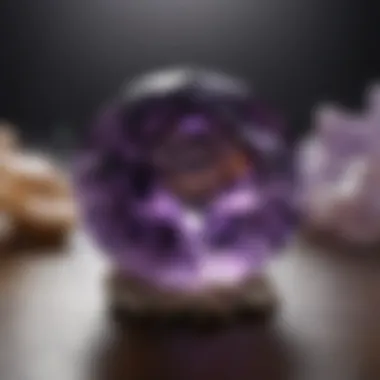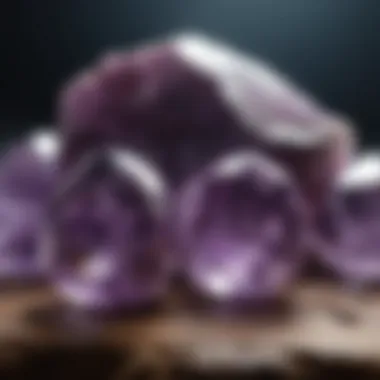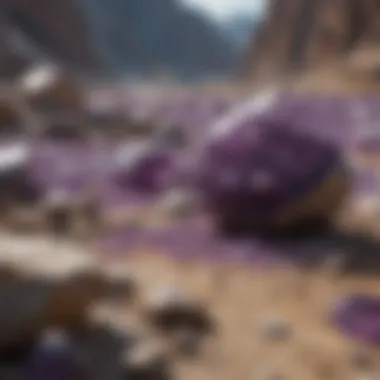Amethyst Cost per Carat: Key Influencing Factors


Intro
The allure of amethyst—a captivating purple gemstone—has fascinated collectors and enthusiasts for centuries. As one moves into the world of gemstones, understanding the nuances of pricing can be quite the labyrinth. It's not merely about its color or sparkle; several layers dictate the cost per carat.
As we delve deeper into the essentials surrounding amethyst pricing, we'll take a closer look at historical roots, identification methodologies, and the various factors that shape its market. This guide is crafted for those who wish to sharpen their insights into the world of natural collectibles, especially in the context of fine minerals and gemstones.
History and Origins
Overview of Collectibles, Rocks, and Fossils
Throughout history, gemstones—including amethyst—serve both aesthetic and practical functions. From the ancient Egyptians, who adorned their pharaohs with rich jewels, to modern-day collectors, the quest for unique stones remains prevalent.
The gemstone industry, which includes collectibles like rocks and fossils, often mirrors broader market dynamics. Amethyst can be considered a stepping stone for many novice collectors eager to dive into the gem world. It's approachable in terms of price, yet stunning nonetheless.
The rising interest in amethyst has resulted in a flurry of information and market exchanges. In online forums and social platforms like Reddit and Facebook, discussions abound over amethyst's characteristics and investment potential.
Historical Significance and Cultural Impact
Amethyst has been celebrated throughout ages. The term itself comes from the Greek word "amethystos," meaning "not intoxicated," which may account for its historical association with sobriety and clear mind. In ancient Rome, soldiers even wore amethyst as a protective talisman in battle.
Conversely, in the Middle Ages, amethyst symbolized royalty; it was often affixed to crowns and adornments. Its rich purple hue characterized wealth and stability, elevating its status to that of a luxury item.
Despite the historical significance, it’s crucial to base modern evaluations on tangible characteristics rather than just folklore.
Identification and Classification
Guide to Identifying Amethyst
Identifying genuine amethyst involves multiple factors.
- Color: The depth and evenness of purple are paramount. Variations range from light lavender to deep purple.
- Clarity: Amethyst can be quite clear, but impurities or cloudiness can impact its value.
- Cut: The manner in which the stone is cut influences its sparkle. Well-cut gemstones command higher prices.
The nuances can be easily overlooked by those new to collecting. Hence, an educated eye is a valuable asset.
Common Types and Variations
Amethyst isn't merely one homogenous stone. Variations abound. Some noteworthy ones include:
- Siberian Amethyst: Known for its deep purple and translucency; highly sought after.
- Rose de France: Lighter in color, but still an appealing choice for collectors.
- Ametrine: A unique hybrid, combining amethyst and citrine, thus creating two colors in one stone.
Each type offers its charm and story, appealing to both seasoned collectors and novice buyers alike.
A notable principle in gemstone valuation: quality characteristics largely inform the cost per carat, making mastery of identification a crucial skill for any collector.
The knowledge obtained through understanding the history, classification, and identification of amethyst allows potential buyers to navigate their investments wisely. As we proceed through this guide, keep these foundational points in focus for making informed decisions in the fascinating realm of amethyst.
Prologue to Amethyst Pricing
Understanding the cost of amethyst per carat is crucial for rock and fossil collectors alike. Amethyst, a variety of quartz known for its rich purple hues, captivates many enthusiasts. But why does the price fluctuate, and what should one consider before purchasing? This section aims to provide clarity on these key questions, ensuring that you not only know the cost but understand the underlying factors that affect it.
Overview of Amethyst
Amethyst is often recognized for its striking color, which can vary widely from a light lavender to a deep, regal purple. This gemstone peers through history as a prized quartz, once adored by royalty. Its allure stems not just from appearance but also from its believed metaphysical properties, like promoting calm and balance. The blend of aesthetic and perceived value draws many collectors into the amethyst market.
However, it’s important to note that not all amethyst is created equal. Different sources yield different qualities, influenced by factors like the mineral composition and environmental conditions during formation. This is where understanding pricing becomes essential.
Significance of Carat Weight
Carat weight holds significant importance in determining the value of amethyst. The cost generally increases with weight, but not in a straightforward manner. Collectors should realize that while larger stones are more valuable, factors such as clarity and color saturation can greatly influence this relationship.
Consider this: a 5-carat stone of poor quality may be worth less than a 1-carat stone with superb color and clarity. Therefore, learning the nuances of carat weight can help collectors make more informed decisions. Amethyst pricing isn't just about size; it's inherently tied to the overall quality of the specimen.
"When engaging in buying decisions, an informed approach is like having a compass in uncharted waters."


Ultimately, grasping the intricacies of amethyst cost per carat helps collectors gauge investments wisely, allowing for choices that not only satisfy aesthetic desires but also align with their financial objectives.
Amethyst Quality Factors
When navigating the world of amethyst pricing, understanding the quality factors is pivotal. Each factor contributes significantly to the overall value of the gemstone, making it essential for collectors and investors alike to grasp these aspects thoroughly. The clarity, color, and cut can mean the difference between a piece that merely catches the eye and one that represents a worthwhile investment. A well-informed buyer is often the one who participates wisely in the marketplace, discerning quality from mere surface appeal.
Color Saturation
The vibrancy of color is one of the most critical aspects in determining the value of an amethyst. This gemstone ranges from pale lilac to a deep, rich purple, and each hue has its fan base. The most prized amethyst features a medium to dark violet or purple with even saturation.
Factors to consider in color saturation include:
- Hue: The primary color should be a true purple; the ideal amethyst resonates with a bluish tone.
- Tone: This refers to the lightness or darkness of the color. A medium tone offers a balance that enhances visibility and aesthetic appeal.
- Saturation: High saturation means the color is vivid and pure without brown or gray overtones.
A stone that epitomizes these characteristics can fetch a higher price, as it not only looks stunning but also signifies good market investment.
Clarity and Inclusions
Clarity is another important factor influencing an amethyst's value. Like other gemstones, amethyst can have inclusions—flaws that can detract from the beauty and sparkle of the stone. Generally, fewer inclusions result in higher clarity, which equals greater value.
When examining clarity in amethyst, take into account the following:
- Inclusions: Look for visible flaws like feathers or needles. The fewer these are, the better.
- Transparency: A clear stone allows light to pass through, enhancing its brilliance.
- Trimming: Some stones might be cut in such a way to hide inclusions, affecting the clarity perception.
Cut and Shape
The cut and shape of an amethyst can dramatically influence its beauty, light refraction, and ultimately, its price per carat. A well-cut stone maximizes brilliance and highlights the natural color characteristics of the gemstone.
In understanding the role of cut and shape in amethyst pricing, consider:
- Brilliance: A good cut allows light to flow through and exhibit its vibrant color. Poor cuts can make even high-quality amethysts appear dull.
- Shape: Whether it’s an oval, round, square, or pear shape, the design should complement the gemstone’s natural features. Popular shapes include the emerald cut for its elegance and the brilliant cut for maximizing sparkle.
- Proportions: Within the cut, proportions can make all the difference. For example, if the table size is too large, light might not reflect properly, leading to a lackluster appearance.
To sum it up, a stunning amethyst— which is rich in color, clear as day, and cut with precision—commands attention. This trio of qualities serves as the backbone of its market value, making it a treasure worth having in any collector’s assortment.
Market Trends in Amethyst Pricing
Understanding market trends in amethyst pricing is crucial for collectors and investors navigating the complex landscape of gemstones. Market trends reflect the economic realities of supply and demand, influencing how amethyst is valued and perceived in both retail and investment contexts. By examining these trends, collectors can make informed decisions that not only cater to their aesthetic preferences but also align with their financial goals.
Historical Pricing Trends
Historically, the price per carat of amethyst has gone through several peaks and troughs. For instance, in the early 20th century, amethyst was considered a precious gemstone, commanding high prices due to its rarity. However, with the discovery of extensive deposits in Brazil, the prices took a hit as supply surged.
- Pre-1970s: High demand, less supply, higher prices.
- Post-1970s: Introduction of Brazilian amethyst raised supply, thus reducing prices.
- Recent Years: Trends have shown a gradual recovery in prices, influenced by factors such as increased interest in gemstone jewelry and the growth of online markets.
Collectively, these historical fluctuations illustrate the delicate balance between demand and supply, emphasizing the importance for collectors to keep a close watch on market dynamics.
Current Market Dynamics
As of now, the amethyst market is influenced by various factors that play a pivotal role in determining its current pricing. The rise of e-commerce has changed the way consumers purchase amethyst products, with online marketplaces offering direct access to global suppliers. Moreover, social media plays an influential role in showcasing gemstone beauty, drawing in new collectors.
- Demand Surge: There’s been a noticeable uptick in demand for amethyst, especially in the wellness and healing communities, which often promote the stone’s purported metaphysical properties.
- Global Supply Chain: With globalization, sourcing amethyst from various regions has become convenient. Yet, not every region produces the same quality, impacting prices.
- Market Sentiment: Economic stability and consumer confidence also affect purchasing power, aligning with luxury spending patterns.
In summary, the current market dynamics are evolving, blending traditional values with modern purchasing methods, which can directly reflect on the prices that buyers encounter today.
Future Pricing Predictions
Looking ahead, predicting the price movements of amethyst involves a mix of economic forecasting and an understanding of collector sentiment. Experts suggest several key elements could play a role in shaping future values:
- Sustainability Trends: As awareness of ethical mining increases, sustainably sourced amethyst may gain a premium. Collectors might favor gemstones that come from responsible sources, which could elevate prices.
- Technological Advancements: Innovations in gemstone identification and treatment may change how amethyst is perceived and priced. Through improved grading standards, buyers may develop more trust in what they purchase, thus potentially increasing overall demand.
- Global Economic Factors: Economic fluctuations can influence luxury spending. In times of prosperity, more individuals may invest in high-quality amethyst, leading to higher prices.
"Predicting future trends in amethyst pricing requires careful observation of market signals and understanding the underlying forces of demand and supply."
Overall, maintaining an awareness of these market trends allows collectors to not only navigate the amethyst landscape but also leverage insights into making strategic purchasing decisions.
Geographical Influences on Amethyst Value


Understanding the geographical influences on amethyst value is paramount for anyone serious about collecting, investing, or simply appreciating these beautiful gemstones. The source of the amethyst plays a critical role in determining its market price, desirability, and uniqueness. This section will explore how factors like mining regions and variations in quality based on location can radically alter the outlook of amethyst as an investment and as a part of personal collections.
Major Amethyst Mining Regions
When it comes to amethyst, certain regions have earned a stellar reputation over the years.
- Brazil: Predominantly known for its abundant and high-quality amethyst deposits, Brazil's stones often showcase a lovely rich purple color that many collectors desire.
- Uruguay: This region is celebrated for producing deep violet crystals with an intense color saturation. The unique geological conditions here contribute to the formation of remarkable gemstones that many enthusiasts seek out.
- Zambia: Not to be dismissed, Zambian amethyst is noted for its significant size and striking color. Many collectors have a soft spot for Zambian stones, as they tend to exhibit a balance of clarity and deep hue.
- Mexico: Interestingly, Mexico has its own unique contributions, especially with the presence of unique crystal formations that come in a myriad of shades.
The geographical context not only affects the aesthetics of the stones but also encumbers the pricing based on market demand and rarity. Amethyst from a distinguished region often fetches a higher price because collectors are more willing to pay a premium for stones with pedigree.
Regional Quality Variations
The concept of quality when it comes to amethyst is inherently tied to its geographical origins. Different regions produce stones that can vary widely in terms of visual allure, durability, and rarity. Here are key factors that highlight why regional variations matter:
- Color Quality: The depth and vibrant quality of the purple hue often differ. Stones from Uruguay might exhibit more intense shades compared to those from Brazil.
- Inclusions: Natural inclusions can affect not just beauty but durability. Crystals from some areas may have fewer blemishes or fewer visible flaws.
- Cut: Often, the skill of local lapidaries can significantly impact the stone's final appearance. Regions with a strong reputation for skilled craftsmanship often produce more visually appealing cuts.
This variation means that not every amethyst is created equal, even if from the same species. Collectors should be aware that stones from certain locations might provide not only aesthetic pleasure but also potential for value appreciation over time.
"Collecting is not just about the rock you hold but the story behind it."
The geographical influences on the value of amethyst remind collectors and investors that the gemstone's narrative, intertwined with location and quality, shapes its place in both personal collections and the broader market.
Evaluating Amethyst for Purchase
Evaluating amethyst for purchase is an important step for anyone considering adding this beautiful gemstone to their collection. Understanding the core elements of this evaluation process ensures not only the acquisition of quality stones but also helps in making sound investment decisions. With the right information, collectors can navigate through the complexities of the gemstone market with greater confidence.
One critical aspect of evaluating amethyst is recognizing its value proposition. Amethyst comes in various qualities and price points, and being able to discern these differences can greatly impact your choice. For example, two stones of equal carat weight may show significant price differences depending on their color saturation, clarity, and origin.
Moreover, purchasing amethyst is not merely about the cost. It’s about appreciating the artistry, the intricate relationship between nature and time that each stone embodies. Collectors should think about the long-term benefits when evaluating a stone; buying quality usually trumps buying quantity. Here are a few key points to consider:
- Educational Preparation: Familiarize yourself with grading reports and appraisal processes. Understanding terms used in the market can empower your shopping experience.
- Market Research: Keep abreast of current pricing trends. Knowing the fluctuations helps you to time your purchase well.
- Networking and Advice: Engaging with fellow collectors or enthusiasts can often yield valuable insights and recommendations. Your peers might point you towards reputable dealers or lesser-known but high-quality sources.
Purchasing amethyst should feel like a journey, not just a transaction. A buyer who is well-informed stands to gain the most—not only from a material perspective but in the satisfaction of making an educated choice.
Where to Buy Amethyst
When it comes to buying amethyst, knowing the right places to look can make a world of difference. Here are a few avenues that provide various opportunities for collectors:
- Gem and Mineral Shows: These events are fantastic for browsing a wide variety of stones and meeting vendors who are passionate about their products. You often get the chance to see the gems up close, which can help in assessing their quality.
- Reputable Dealers: Search for established dealers who have a history of good reviews and who can provide certifications for the amethysts they sell. Look for shops that are part of professional organizations.
- Online Marketplaces: Websites such as eBay or Etsy offer a range of options, but ensure you do your due diligence—check seller ratings and inquire about return policies.
- Auction Houses: Elite auctioneers sometimes feature lots of high-quality gemstones. This route might be suitable for those looking for unique or rare pieces, often amidst competitive bidding.
Remember, wherever you choose to purchase your amethyst, the emphasis should always be on quality and authenticity.
Understanding Certification and Grading
The certification of amethyst brings an extra layer of assurance to collectors. A certificate from a recognized grading authority provides documentation regarding a stone’s characteristics. Common grading entities include the Gemological Institute of America (GIA) and the International Gemological Institute (IGI). Certification exists to clarify any confusion about a stone's quality and value. In general, this kind of documentation will cover aspects such as color, clarity, and cut.
In turn, grading affects the market price significantly. Consider the following:
- Color Grading: Amethyst is evaluated based on its hue, tone, and saturation. Darker shades often fetch higher prices, but the ideal color is a balance that attracts a broader audience.
- Clarity Assessment: A clear amethyst is a coveted one. GIA typically grades clarity from Flawless (no inclusions visible under 10x magnification) to Included (inclusions that are easily visible).
- Cut Quality: A skillfully cut amethyst can enhance its brilliance and aura, making it stand out in any collection.
Investing in well-certified amethyst offers peace of mind, and understanding the grading process equips collectors with the knowledge needed to make informed decisions that stand the test of time.
"In this complex gemstone market, knowledge is your best ally, empowering you to differentiate between genuine investment and mere illusion."
Being educated not only helps you select better stones but also arms you against potential scams.
Whether you’re a seasoned collector or a novice, being thorough in your evaluation process is key to building a rich and meaningful collection.
Investment Considerations
Investing in amethyst can be a rewarding venture for collectors and enthusiasts alike. Understanding the intricacies associated with the cost per carat is essential to making astute investment decisions. Embracing this topic sheds light on the long-standing value of these stones, along with potential growth in worth over time.
One of the primary aspects to consider is the long-term value of amethyst. Quality factors—like saturation, clarity, and provenance—can significantly influence future market appeal. This is akin to the real estate market where location and neighborhood condition dictate property value. In the world of gemstones, a rich color hue and high clarity are akin to prime locations, likely to appreciate in value over time.


Assessing Long-term Value
When evaluating amethyst for long-term investment, keep a sharp eye on market demand and rare qualities. As the earth's resources dwindle, gemstones that were once abundant might become scarce over time. One must examine the historical prices of amethyst as well as the current trends in color variety and layout.
Investors often refer to primary markets, such as Madagascar, Brazil, and Zambia, which currently lead in quality output. Observing transaction patterns within these locales can offer predictive insights about potential future pricing shifts. For example:
- Amethysts with a deep royal purple color, known as "Siberian amethyst", have long commanded higher prices due to their rarity, akin to a collector’s item that only appreciates with age.
- Stones with strong clarity and a smooth cut, particularly those that can showcase brilliance without interference from inclusions, tend to attract higher bids in auctions.
Therefore, assessing long-term value involves looking not only at the gemstone’s inherent qualities but also its market narrative and historical significance within the collector community.
Diversification Through Amethyst
The concept of diversification is key to any strong investment strategy. Like a well-balanced diet, one should not rely solely on one type of asset but rather on a mix that nurtures sustainable growth. In the case of amethyst, it offers a unique niche—bridging the line between aesthetic enjoyment and financial stability.
Investors may find that adding amethyst to their collection can serve as a hedge against market volatility, especially in uncertain economic climates. Here are a few points to ponder:
- Cultural and Emotional Value: Crystals have spiritual associations that many collectors cherish. By incorporating amethyst, one not only enhances their collection but also brings personal meaning into the portfolio.
- Market Resilience: Traditional investments, like stocks and bonds, can be unpredictable. However, as more people discover the beauty and significance of gemstones, demand for amethyst can rise, potentially insulating one against economic ebbs and flows.
- Transcultural Appeal: Amethyst has transcended various cultures, which contributes to its steady demand. While some gems may gain luster in specific regions, amethyst has a universal charm that captures attention globally, from jewelry artisans to spiritual practitioners.
"Investing in amethyst isn’t just about monetary gain; it encapsulates a blend of artistry, rarity, and personal connection."
Thus, investing in amethyst not only diversifies one’s portfolio but also enriches it with beauty, stories, and connections that might outlast financial trends. It stands as jewelry to wear, a collectible to admire, and an asset to appreciate.
Caring for Amethyst
Caring for amethyst is not just about preserving beauty; it dives into maintaining its value over time. For collectors and enthusiasts alike, understanding how to properly care for amethyst helps in protecting these precious gems from potential damage. This section equips you with practical knowledge on cleaning, maintenance, and storage, ensuring your gem holds its worth and charm.
Cleaning and Maintenance
When it comes to cleaning amethyst, the process is relatively straightforward but requires attention to detail. Amethyst is relatively hardy, scoring around a 7 on the Mohs scale, which means it's resistant to scratches. However, its beauty can be dulled by dirt and oils. Here are several points to keep in mind:
- Use Mild Soap: A gentle soap mixed with lukewarm water is usually enough. Avoid harsh chemicals that can damage the stone.
- Soft Brush: A soft toothbrush can help clean the crevices without scratching the surface. Just a light touch is all that's needed.
- Rinse Thoroughly: After cleaning, rinse the amethyst under running water to remove soap residues.
- Dry Carefully: Pat it dry with a soft, lint-free cloth. Avoid rubbing, as this can cause micro-scratches.
Regular maintenance is equally important. Taking a few moments to inspect the stone for signs of wear or damage can save you from bigger issues down the line. If you plan on displaying your gems, ensure they are not in direct sunlight for extended periods, as this can lead to fading in color.
"Proper care ensures that a piece of amethyst can be cherished for generations, not just as a collector’s item but as a family heirloom."
Storing Amethyst Properly
Storage plays a crucial role in preserving amethyst’s quality. Many enthusiasts overlook this aspect, but how you store your gems can significantly impact their longevity. Follow these tips for effective storage:
- Individual Cases: Store each piece separately to prevent scratches from other stones. Jewelry pouches or individual compartments in a box work well.
- Avoid Pressure: Don’t stack heavy items on top of amethyst. The weight can cause fractures or chips.
- Temperature Control: Keep your amethyst in a cool, dry place. Extreme temperature fluctuations can cause stress within the stone, leading to cracks.
- Non-chemical Packaging: If using plastic bags, ensure they’re chemical-free, as some materials can emit harmful substances.
By taking these steps, you'll not only maintain the beauty of your amethyst but also secure its value as part of your collection. Amethyst deserves respect and careful handling, and understanding how to care for your stones is paramount to enjoying them for years to come.
Final Thoughts on Amethyst Cost per Carat
Understanding the cost of amethyst, particularly on a per-carat basis, is a journey through a complex interplay of factors, each shedding light on the intrinsic value of this stunning gemstone. As we conclude this discussion, it's essential to reflect on the many elements that contribute to determining amethyst's worth. This article has emphasized how quality, market conditions, and geographical nuances all play pivotal roles in pricing.
The significance of being informed about these aspects cannot be overstated. For collectors and enthusiasts, knowing how to evaluate amethyst thoughtfully can dramatically enhance investments and enrich personal collections. The careful scrutiny of color saturation, clarity, and cut is not just academic; it translates into real-world decisions when purchasing or selling amethyst.
Moreover, market trends highlight the evolving nature of pricing, showing how history and current events can reshape value perceptions. This information is particularly valuable for prospective investors looking to navigate the sometimes fickle nature of gemstone markets.
In essence, comprehending amethyst pricing equips individuals with the tools necessary to make smart choices, potentially avoiding hasty purchases that could lead to regret. Recognizing these elements helps collectors align their purchases with their goals, be they aesthetic, sentimental, or financial.
"Knowledge is power, especially in the world of gemstones, where every detail counts."
By grasping the nuances discussed throughout this article, one can steer clear of pitfalls that can come from a lack of understanding. The art of collecting fine minerals and gemstones, such as amethyst, requires more than passion; it demands a sound grasp of valuation principles that are rooted in solid knowledge.
Summary of Key Points
- Quality Attributes: The color, clarity, and cut of amethyst are foundational in assessing its price per carat. Each quality factor holds significant weight in the overall evaluation.
- Market Dynamics: Historical pricing trends can inform future expectations, while current market conditions may influence buying decisions.
- Geographical Impact: The source of the gemstone affects its rarity and desirability. Understanding the mining regions can lead to better purchasing decisions.
- Investment Insight: Acquiring knowledge on amethyst pricing can enhance one’s collecting strategy, ensuring clarity on potential long-term value.
Encouragement for Informed Collecting
As you embark on your journey of collecting amethyst, let informed decision-making be your compass. The world of gemstones can be overwhelming, filled with temptations to rush into purchases without adequate research. Instead, take your time to dissect each potential buy with a critical eye.
Build a toolkit of knowledge; read reputable sources, engage in discussions on forums like Reddit, and share insights with fellow enthusiasts on platforms such as Facebook. Join online communities that focus on rock and fossil collecting or gemstones, as these can become invaluable resources.
Also consider documenting your findings and experiences. This practice not only reinforces what you learn but also helps track your own progression as a collector. There’s no rush in this endeavor. Each piece in your collection tells its own story; the longer you take to know its nuances, the more meaningful that narrative will become.
Ultimately, the allure of amethyst lies not just in its beauty but in the adventure of acquiring knowledge around its cost and value. Collect wisely, knowing the worth of your stones goes far beyond their monetary value.



